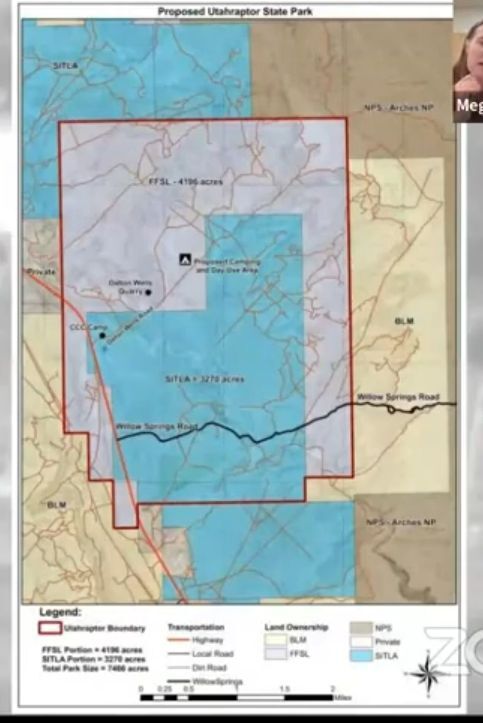The designation of Utahraptor State Park in 2021 answered the wishes of many local and state advocates who hope to see better management of a state-owned parcel of land north of Moab. The land holds valuable resources like dinosaur fossils, historical sites and recreational opportunities, but overuse by campers and visitors had been damaging the area.
The Utah Division of State Parks is working toward developing Utahraptor State Park and becoming operational in 2023. At the Dec. 21 meeting of the Grand County Commission, Megan Blackwelder, Southeast Utah regional manager for the Utah Division of State Parks, and Joshua Hansen, park manager and sole current employee of Utahraptor State Park, gave an update on the progress of the new park.
Boundaries and developments
Through a purchase of land by the Utah Division of State Parks from the Utah School and Institutional Trust Lands Administration and a permit agreement with the Utah Division of Forestry, Fire and State Lands, the boundaries of the park cover 7,466 acres. The park is located in the Willow Springs/Dalton Wells area north of Moab and mostly east of Highway 191; the southwest corner of the park crosses over to the west side of the highway.
House Bill 257, which designated both Utahraptor State Park as well as Lost Creek State Park in Morgan County, appropriated $36.5 million to be used for the renovation and development of both parks; $7.5 million of the funding was earmarked for land purchases for Utahraptor State Park.
The available funding won’t be enough to completely build out the park according to early designs. An early vision included two developed campgrounds, each with between 40 and 60 sites. Hansen said he and other planners wanted to make sure the campgrounds are built to high standards and opted to focus on building out the first, the Willow Springs Campground, which will have electrical hook-ups, a picnic table, a shade structure, and a fire ring at each site. There will also be flush toilets and showers as well as an RV dump station.
Hansen said that major improvements to the Dalton Wells Campground will have to wait for a later time when the park can obtain more funding. For now, the Dalton Wells Campground will remain primitive, though the surface will be hardened and there will be designated camping sites. There will be no dispersed camping within the park boundaries.
A visitor center with an indoor interpretive section will be built next to an improved highway entrance/exit. There won’t be a full-blown museum, but there will be displays discussing the significance of the paleontological resources in the park, as well as of a historic site used to house the Civilian Conservation Corps and later to hold Japanese-Americans in an isolation center in the 1940s. Grand County as well as nonprofit the Utah Friends of Paleontology will contribute funds toward the exhibits. There will also be a small gift shop.
“This will give us an opportunity to showcase the reasons why Utahraptor State Park was designated in the first place,” Blackwelder said.
Blackwelder and Hansen noted that staff at the state park entrance station will be able to give visitors information and messaging regarding other land management agencies whose properties may be accessed through the state park. Those entering the park to access areas owned by other entities, such as the BLM or the National Park Service, will be allowed to pass through free of charge.
The first stage of construction will also include housing for park employees. As of now, Hansen is the only employee; he said it’s uncertain yet how many other employees will be hired, or when. The park will need staff to operate the visitor center, patrol, and conduct maintenance.
So far, a 1600-foot well has been drilled to supply the park. Hansen said the water will have to be treated to make it drinkable; a reverse-osmosis system will be installed onsite.
Managing the present state
To carry out the full improvement of the Dalton Wells Campground, Utahraptor will ask the state legislature to appropriate more money for the project. In the meantime, Hansen said he’s doing his best to mitigate impacts from overused areas and regulate where people camp.
“Right now people are driving as far off the road as they possibly can get,” Hansen said. “There are some places people are camping that are just ridiculous. It’s exponentially growing, every year people find new spots.”
Dispersed camping in the area had been a growing concern for the Moab community, with trash and human waste accumulating and vehicle tracks damaging vegetation and soils. It’s hoped that the establishment of the park, in addition providing another attraction for Moab’s many visitors, will regulate use of the area and allow for restoration to occur.
Starting this spring, a $10 camping fee will be implemented in the area to help cover the costs of portable toilets and dumpsters that have been provided. Hansen said that during the high seasons of spring and fall, the facilities need to be emptied and cleaned twice a week. The cost of that maintenance is significant. Fees this spring and summer will be collected through an “iron ranger,” an unstaffed solid fee box.
The park also encompasses about 50 miles of trails, many within the Sovereign trail system for bikes and motorized vehicles. Hansen said that while construction is underway, he’ll ride, map and assess the trails to determine their sustainability and safety and whether they should remain open. He anticipates that they will mostly be acceptable. For now, all those trails remain open.
Blackwelder and Hansen said the park will be operable in 2023 and charge separate as yet undetermined fees for day use and camping. A fiscal note included with HB 257 says the entry fee could be up to $25 and the camping fee up to $40; it estimates annual operating costs of the two parks, once functional, to be $698,000, and annual revenues to be $798,500.




